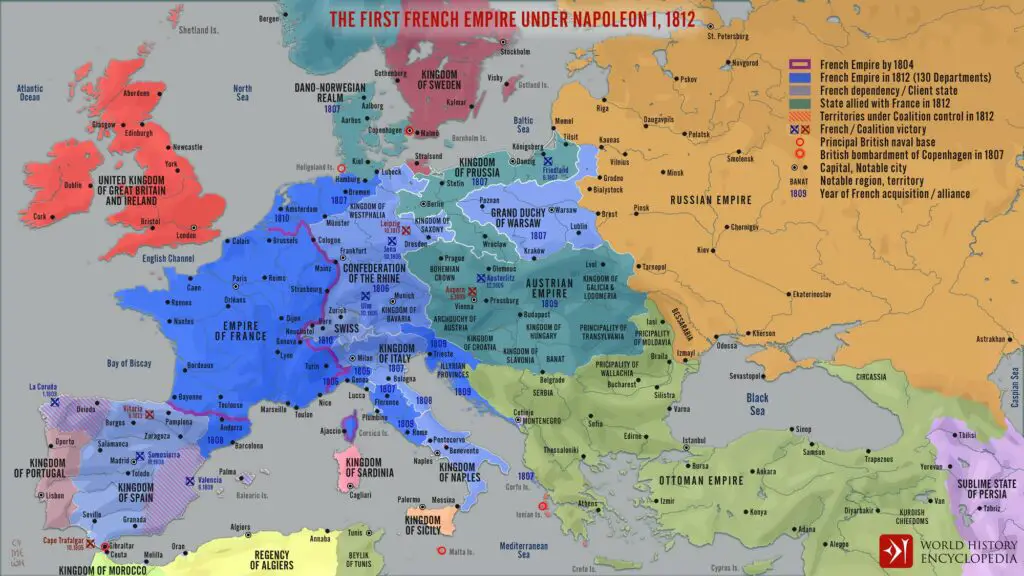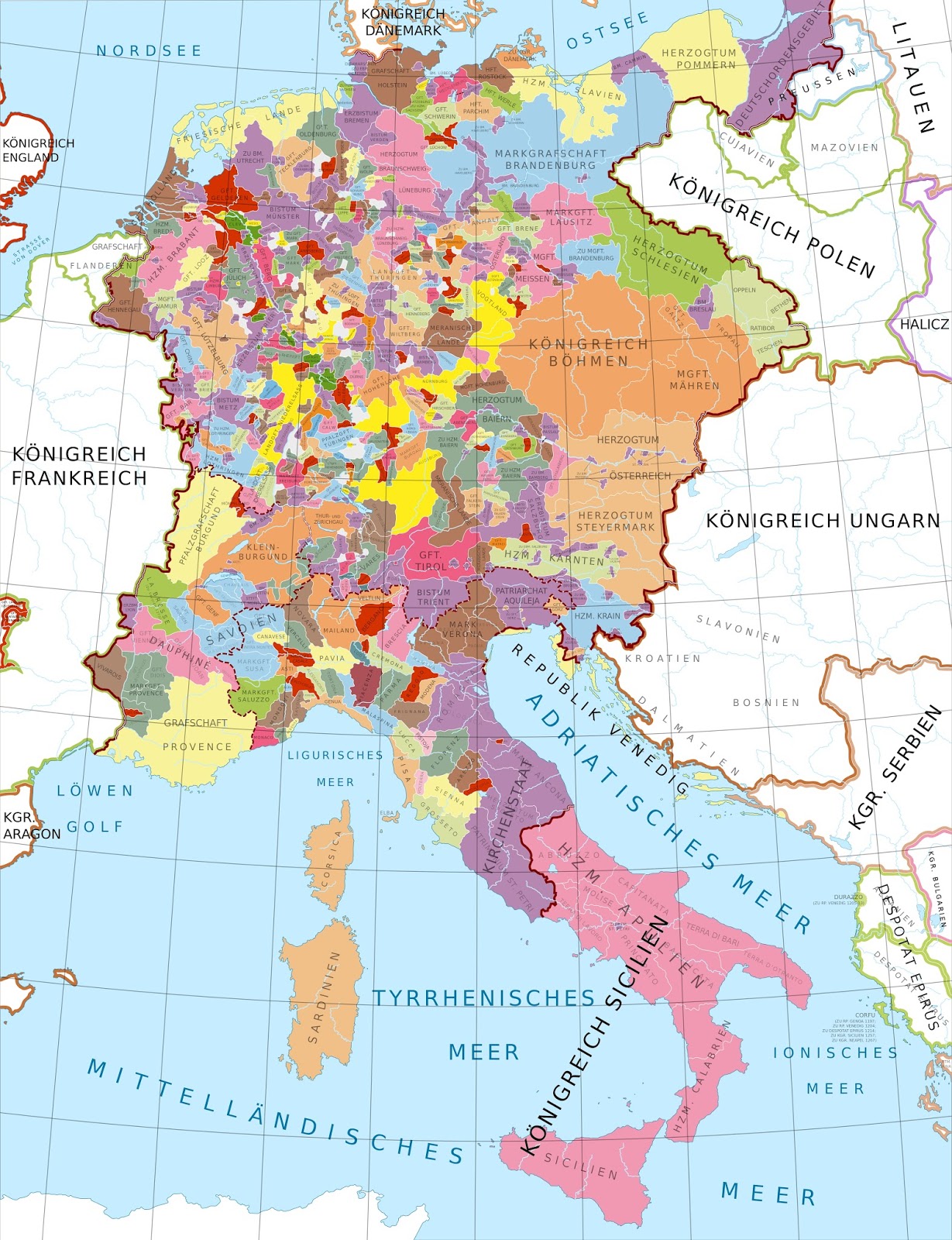A History of France in Maps
As one of the oldest countries in the world, France has a rich and captivating history, including epic events like the Roman conquest of Gallia or Gaul (France), the French Revolution, the Napoleonic Wars, and the Hundred Years’ War. Here’s a brief overview of the history of France.
Table of Contents
Ancient and Medieval Periods
- The region now known as France has a long history dating back to prehistoric times, with evidence of human habitation from as early as 1.8 million years ago.
- The area was inhabited by Celtic tribes until the Roman Empire’s conquest in the 1st century BCE.
- France, then called Gaul, became an integral part of the Roman Empire, experiencing Roman influence and development during this period.
- Following the fall of the Western Roman Empire in the 5th century CE, various Germanic tribes, including the Franks, established their presence in the region.
Middle Ages and Renaissance
- The Franks, under Charlemagne’s leadership, formed the Carolingian Empire, which encompassed much of Western Europe in the 9th century.
- The Carolingian Empire eventually fragmented into smaller feudal territories, laying the groundwork for the emergence of modern France.
- In the 11th century, William the Conqueror, Duke of Normandy, invaded England and became its king, establishing close ties between the two regions.
- The Capetian dynasty ascended to power in France in the 12th century, gradually consolidating their rule and expanding their territory.
- The Hundred Years’ War (1337-1453) between France and England had a profound impact on the country, ultimately resulting in French victory and territorial unity.
Below is the map of France in the year 987.
France in 987

Living in France in 987 was characterized by a feudal society with a fragmented political landscape. The region was under the rule of various feudal lords, and the power of the monarchy, under King Hugh Capet, was still in its early stages of consolidation. Society was largely agrarian, with a hierarchical structure dominated by the nobility and clergy. Most people lived in rural areas, working as peasants and engaging in agricultural activities, while trade and commerce were limited. The cultural and artistic achievements of the period, such as Romanesque architecture, were beginning to emerge. Here is the map of France in 1030, when the domains of the French monarchy were at their smallest point in history.
A Map of the Angevin Realm in the Twelfth Century
The Angevin Realm, also known as the Angevin Empire or the Plantagenet Empire, was a vast territory in Western Europe during the 12th and 13th centuries. It was established and ruled by the Plantagenet dynasty, with Henry II as its first Angevin king. The realm included England, large portions of modern-day France (including Anjou, Normandy, Aquitaine, and Gascony), as well as parts of Ireland, Wales, and Scotland. The Angevin kings, particularly Henry II and his son Richard the Lionheart, played significant roles in European politics, engaging in conflicts such as the Crusades and the struggles for power within the English monarchy. The Angevin Realm came to an end with the death of King John in 1216 and subsequent territorial losses.

Living in France in the twelfth century was marked by significant social, political, and cultural changes. Feudalism continued to dominate society, with a hierarchical structure and a powerful aristocracy. The rise of towns and trade led to the growth of the middle class and a shift towards a more urban lifestyle. The troubadour culture thrived, with poetry and courtly love gaining popularity. The Romanesque style of architecture prevailed, and Gothic architecture began to emerge, exemplified by the construction of iconic cathedrals such as Notre-Dame de Paris. The intellectual movement of scholasticism also took root, fostering academic pursuits and the establishment of universities.
Early Modern Period
- The Renaissance brought cultural and intellectual changes to France, with advancements in arts, literature, and science.
- Religious conflicts, notably the Wars of Religion between Catholics and Protestants, ravaged France in the 16th century until the issuance of the Edict of Nantes in 1598, granting limited religious tolerance.
- Monarchical power was further consolidated under Louis XIV, known as the Sun King, who centralized the state.
French Revolution and Napoleonic Era
- The French Revolution, starting in 1789, marked a significant turning point by overthrowing the monarchy and initiating radical political and social transformations.
- The Revolution led to the establishment of the First French Republic and eventually saw the rise of Napoleon Bonaparte.
- Napoleon became Emperor in 1804 and embarked on a series of military campaigns, creating a vast French Empire across Europe.
- The Napoleonic Wars continued until 1815 when Napoleon was defeated and exiled, leading to the restoration of the Bourbon monarchy.
This map, published by Simeon Netchev for the World History Encyclopedia, depicts the expansion and heyday of the First French Empire in 1812, with Napoleon Bonaparte at its head.

On the map, the purple line shows the extent of the French Empire in 1804, while the blue depicts all the possessions of the French Empire in 1812. Other territories directly dependent on France in 1812, are shown in light blue.
Modern France
- The 19th century witnessed political instability in France, including various forms of government such as constitutional monarchy, two empires, and multiple republics.
- France experienced industrialization, urbanization, and colonial expansion during this period.
- The two World Wars in the 20th century had a profound impact on France, resulting in significant human and material losses.
- After World War II, France played a pivotal role in the establishment of the European Union and became a founding member.
- Since then, France has undergone social, cultural, and economic transformations, evolving into a modern democratic country known for its cultural heritage, contributions to art and philosophy, and global influence.









marked gap between 12C & 19C